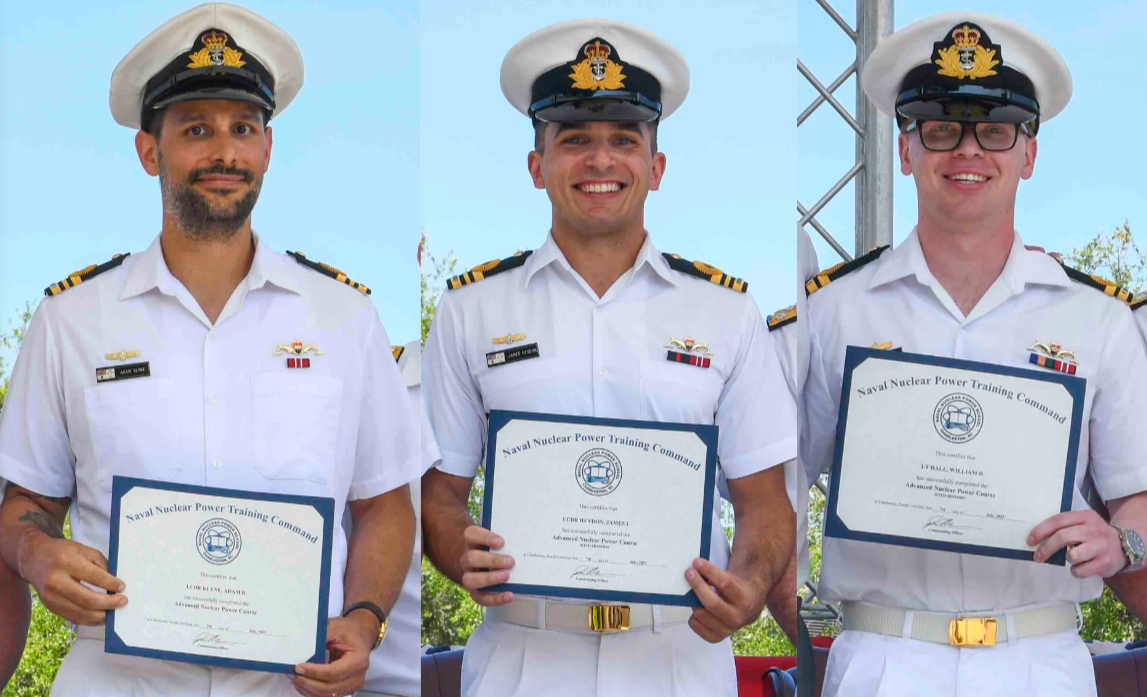
Royal Australian Navy graduates from Naval Power School (l to r) Lt. Cmdr. Adam Klyne, Lt. Cmdr. James Heydon and Lt. William Hall. US Navy Photos
The first of a new cadre of nuclear-trained Australian sailors graduated on Friday from nuclear power school in Charleston, S.C.
The three Royal Australian Navy officers completed the service’s six-month Naval Nuclear Power Training Command and Nuclear Power School, which teaches the fundamentals of running U.S. naval nuclear reactors on submarines and aircraft carriers.
“It’s a historic event for our Navy, a historic event for our submarine force and I think it’s a historic event for our nation,” said Australia’s Chief of Navy, Vice Admiral Mark Hammond, according to Australian broadcaster ABC.
“Two years ago, this wasn’t on the radar.”
The graduation of the RAN officers Lt. Cmdr. James Heydon, Lt. Cmdr. Adam Klyne and Lt. William Hall is one of the first steps ahead of the introduction of nuclear submarines into the Australian fleet as part of the AUKUS technical cooperation agreement between the U.S., Australia and the U.K.
“What these graduates learn at NPS prepares them for the next step in becoming a nuclear-qualified officer,” Adm. Frank Caldwell, director of the Naval Nuclear Propulsion Program, said in a Friday statement.
“From here, they will continue their academic and practical studies so that when they go to their aircraft carrier or, in the case of our RAN officers, submarines, they are ready to safely and competently operate the power plant.”
Following the completion of the South Carolina training, the three sailors will undertake additional training at the Navy’s moored training ship and then in Connecticut to be qualified officers to serve aboard U.S. Virginia-class nuclear attack boats operating out of Hawaii.
“The plan at this stage is to join submarines based in Pearl Harbor, Hawaii, and they’ll complete their training at sea,” Hammond said.
“Once they’re qualified, sufficiently experienced, then we’ll get them back into the ecosystem in a different role.”
Nuclear-trained RAN officers serving on U.S. submarines is one of the first steps of the AUKUS construct that will eventually lead the Australians to operate their own Virginia-class submarines.
“One of the key elements to AUKUS that screamed out for immediate attention was helping the Australian Royal Navy gain proficiency in the operation and stewardship of nuclear-powered submarines. All other elements of AUKUS could succeed, but without training, the Australian Royal Navy won’t have the skills to operate or care for the submarines,” Rep. Joe Courtney (D-Conn.), ranking member of the House Armed Services seapower and projection forces committee, told USNI News in a statement.
The next steps will have U.S. submarines make more port calls in Australia and send hundreds of Australian shipyard workers to the U.S. to learn the art of submarine construction and maintenance.
“Once we feel that Australia is ready to do that – and we think it could be as early as 2027 – we’ll establish a rotational force of U.S. and U.K. submarines in Australia, the construct we’re calling Submarine Rotational Forces West,” or SURF-West, a White House official told USNI News.
The pact between London, Washington and Canberra aims to have the first nuclear attack boats in Australia by the 2030s and the first Australian-built subs by the 2040s.
https://news.google.com/rss/articles/CBMihAFodHRwczovL25ld3MudXNuaS5vcmcvMjAyMy8wNy8wNy9maXJzdC1hdXN0cmFsaWFuLXNhaWxvcnMtZ3JhZHVhdGUtZnJvbS1udWNsZWFyLXBvd2VyLXNjaG9vbC1zZXQtdG8tc2VydmUtb24tdS1zLW5hdnktc3Vicy1pbi1oYXdhaWnSAQA?oc=5
2023-07-07 23:17:00Z
2172589914
Bagikan Berita Ini














0 Response to "First Australian Sailors Graduate from Nuclear Power School, Set to Serve on U.S. Navy Subs in Hawaii - USNI News - USNI News"
Post a Comment